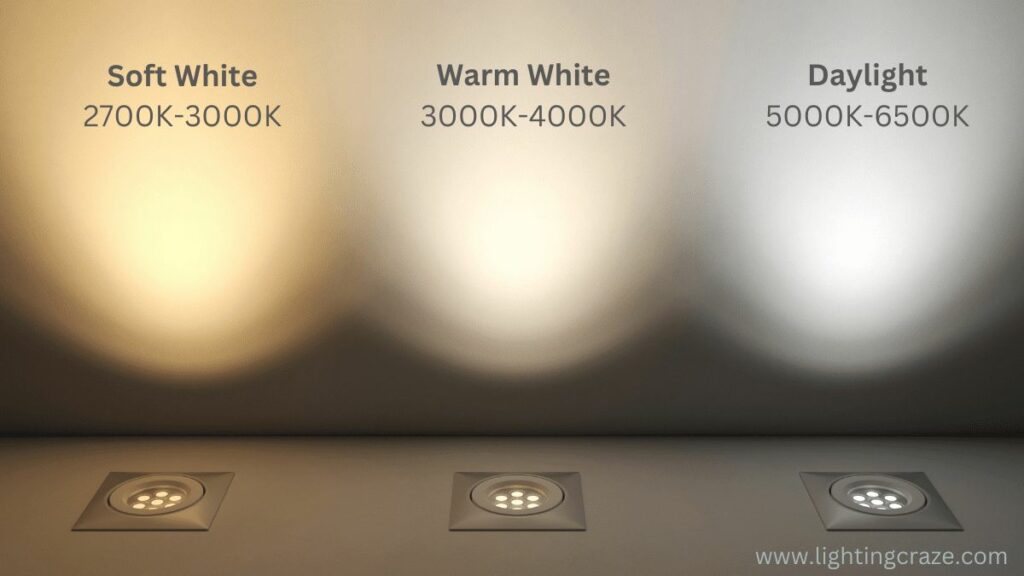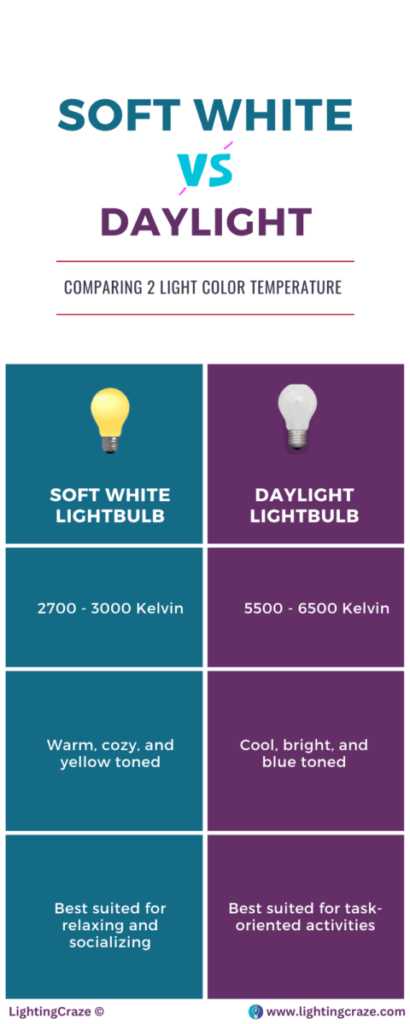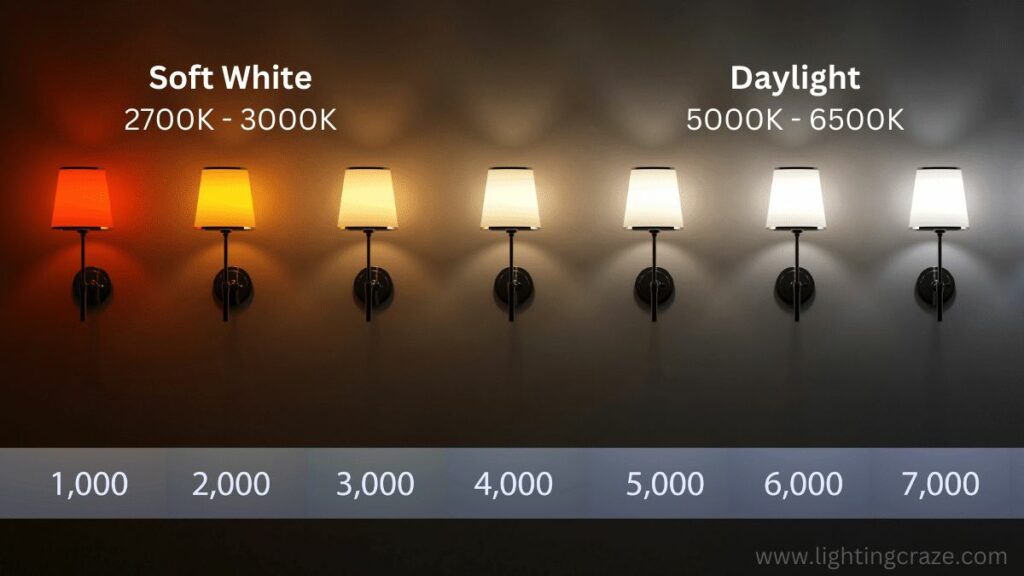Color temperatures like soft white and daylight have the power to transform the essence of a space, ambiance, and atmosphere. To achieve the most optimal visual and feel, you need to select the right color temperature, factoring in their fundamental differences.
The main difference between soft white vs. daylight is their color temperature and hue. Soft white lights have a color temperature of 2700K-3000K which emits a warm, yellow-toned light, while daylight bulbs have a 5000K-6500K color temperature which produces cool and blue-toned light.
This blog post sheds light on all the key differences between soft white vs. daylight, their pros and cons, and their ideal applications. Let’s hop in!
Soft White vs. Daylight: Color Contrast

As established earlier, soft white and daylight bulbs differ in color temperature, measured in Kelvin (K). Based on their light temperatures, both LED light colors have distinct characteristics:
- Soft white lights have a color temperature of around 2700K-3000K, while daylight bulbs have a color temperature of 5500K-6500K.
- Soft white lights emit a warm tone and a yellowish hue which reflects coziness and a homely ambiance. Whereas daylight bulbs cast a cool tone and a blueish hue that mimics natural daylight, creating an energetic ambiance.
- Daylight bulbs can are more bright, whereas soft white lights are a bit dim and mild.
- Soft white lights are best for use in residential spaces, like bedrooms, living rooms, and dining rooms. On the contrary, daylight bulbs serve better in commercial or high-task settings, including offices, libraries, and outdoors.
What is Soft White Light Bulb?
Soft white light is a type of light that emits a warm, inviting glow. These bulbs typically have a color temperature of around 2700K-3000K, which means they’re on the warmer end of the color spectrum. This warmth gives soft white bulbs an inviting and cozy atmosphere in any space.
Unlike daylight bulbs, soft white bulbs produce a more yellow-toned light that mimics the gentle glow of candlelight, a mild sunset, or an incandescent bulb.
Advantages of Soft White LED Lights
- Mimics the gentle glow of candlelight or a sunset.
- More flattering to skin tones than cooler-toned bulbs.
- Perfect for relaxation or intimate moods and settings.
- Produces yellow-toned light, which is easy on the eyes, reducing eyestrain and fatigue.
- Enhances the overall aesthetic of a space, creating a cozy, soothing, and comfortable feel.
Disadvantages of Soft White LED Lights
- May not be suitable for areas where bright lighting is needed.
- May not be ideal for spaces with cooler color schemes, such as rooms with blue or green accents.
- May not be as energy-efficient as cooler-toned LED bulbs, which can lead to relatively higher electricity bills.
Examples of Soft White LED Lights
- An LED lightbulb emitting light-yellow hues.
- Any lightbulb producing yellowish-white light tones.
Where Should You Use Soft White Bulbs?
Soft white light bulbs are a versatile lighting option used in various settings to create a warm and inviting ambiance.
You can use these warm hues in living rooms, bedrooms, nurseries, and bathrooms. Moreover, if you want to set the mood for a romantic evening or a peaceful ambiance, consider swapping out your harsh lightbulbs for soft white ones.
However, soft white lights may not be the best choice for areas where bright task lighting is needed, such as your home office or workshop.
What is Daylight Light Bulb?
Natural daylight has a certain quality that can’t be replicated by artificial lighting. But daylight lightbulbs very closely mimic the natural sunlight — they are bright and clear and make everything look better.
Daylight light bulbs are designed to mimic the color temperature of natural daylight, typically around 5500K-6500K. They have a bright, cool, blueish tint perfect for creating an energizing, productive atmosphere in your home. Daylight light bulbs also have the added benefit of making colors look more true-to-life.
Advantages of Daylight LED Lights
- Enhances mood, energy levels, and productivity.
- Makes a room appear larger, creating a bright and open environment.
- Complements natural materials and brings out their true colors and textures.
- More energy-efficient, as it uses less energy to produce the same level of brightness.
- Improves visibility and provides the most accurate and balanced color representation.
Disadvantages of Daylight LED Lights
- May highlight imperfections in surfaces and finishes.
- May appear too blue or artificial, making a space feel sterile or clinical.
- May be too harsh in the evening or at night when a warmer, more relaxing light is needed to create a cozy atmosphere.
- May be more difficult to control than soft white light, as it can easily spill into adjacent areas or create unwanted shadows and glare.
Examples of Daylight LED Lights
- An LED bulb producing white light.
- Any form of light emitting bluish-white light tones.
Where Should You Use Daylight Bulbs?
Daylight lightbulbs are a luminous addition to any home or space. Use them in areas lacking natural light, such as basements, attics, and rooms with small or few windows.
Another great use for daylight bulbs is in spaces where you want to boost productivity and focus and where you want to showcase colors and details. Offices, study areas, sewing rooms, and kitchens can benefit from the energizing effects of daylight color light.
However, daylight may not be the best choice for areas where you want to relax and unwind, such as bedrooms or living rooms.
What is The Difference Between Daylight and Soft White?
When it comes down to choosing between soft white and daylight lighting — you have to get the inside scoop.
The main difference between soft white vs. daylight is their color temperature and the light color and hue they produce. But that’s not all!
Here’s a table that outlines all the key differences between soft white vs. daylight lighting:
| Criteria | Daylight | Soft White |
| Color temperature | 5000K-6500K Kelvin (Cool) | 2700K-3000K Kelvin (Warm) |
| Appearance, Hues and Tones | Cool, bright, and blue toned | Warm, cozy, and yellow toned |
| Best suited for | Task-oriented activities | Relaxing and socializing |
| Commonly used in | Kitchens, bathrooms, offices | Bedrooms, living rooms, hallways |
| Mood | Energizing and refreshing | Relaxing and calming |
| Eye strain | May cause eye strain | Less likely to cause eye strain |
| Suitable Fixtures | Floor and table lamps, bedroom, living room, and chandeliers | Overhead lighting, offices, study, and vanities |
| Energy efficiency | Typically more efficient | Typically less efficient |
| Availability | LED, incandescent, strip lights, puck lights, can lights etc. | LED, ceiling, and strip lights. |
So there you have it! Compare the differences between soft white vs. daylight and make the switch to the right lighting.
Don’t settle for boring illumination — bask in the beauty of your new inviting oasis.
Soft White vs. Daylight: Ideal Applications and Uses for Your Home & Commercial Settings
The right lighting can make your space radiate warmth, charm, and an inviting embrace, transforming it into a cozy haven you won’t want to leave. But how do you choose between soft white vs. daylight bulbs for your home or commercial space?
Here’s our expert suggestion to help you navigate this dilemma and make the perfect lighting decision for every space:
Soft White or Daylight for Bathroom

Soft white lights (3000K) have a warm, earthy, and pleasant hue, while daylights (6000K) bring a lot of cool brightness to the space.
In bathrooms and vanities, you need a light color that combines the best of both lighting colors. Aim for a light color temperature between 3000K (soft-white) and 5000K (cool white). This range combines the warmth of soft-white lighting with the cool brightness of daylight, giving you the perfect balance of illumination.
So next time you ponder between soft white vs. daylight bulbs for the bathroom, remember the ideal light color temperature for a bathroom is 4000K.
But before you make your final decision, factor in the colors of your cabinets, countertops, and walls, as well as the size of your bathroom and the natural light it receives.
Soft White or Daylight for Kitchen

Soft white lightbulbs with a color temperature of 3,000 to 4,000K are considered the best color light for the kitchen.
However, these warm hues work best for traditional wooden kitchens to keep the natural ambiance intact. For a contemporary kitchen, it is best to add daylight color light for a bright and clean look.
Moreover, it’s important to consider the color of your cabinetry when choosing between soft white vs. daylight color light for your kitchen.
| PRO TIP For light-colored cabinets, you should opt for a cool white light from 4000K-5000K on the light color temperature chart. For darker color-themed kitchens, a “warm” light in the 2700K-3500K color temperature range would be more suitable. |
Soft White or Daylight for Bedroom

Being the two most popular lighting options, it’s understandable to get confused about which color to choose: soft white or daylight bulbs for the bedroom.
When it comes to bedroom lighting, daylight or bright white LEDs are not the wise option. They are relatively harsh on the eyes and may affect your sleep cycle negatively, keeping you awake late at night.
To ensure a calming and cozy environment, add soft white light within the range of 2000K to 3500K. This bedroom color lighting temperature helps your circadian rhythm (sleep cycle) as well as reduces eye strain and headache. So, bask in these tried-and-true warm white hues, and you are bound to feel comforting and relaxed.
Soft White or Daylight for Living Room

The living room is the center of a home where all the family members gather, sit, chat, and socialize. In a setting like this, it’s best to install a soft white lightbulb.
Soft white light creates a cozy and warm atmosphere, igniting the homely feeling that’s hard to catch with daylight bulbs. This warm color temperature is just the ambiance you need to throw in a party, an intimate gathering or even a formal office meeting.
Soft White or Daylight for Outdoor

Both Soft White and Daylight have their unique advantages and disadvantages.
But when it comes to your outside lighting, it’s best to opt for daylight lightbulbs. This light is perfect for illuminating outdoor spaces such as walkways, patios, or decks and can create a safe environment for you and your guests. However, the warm glow of daylight bulbs is the better option to install in the pool area.
Soft White or Daylight for Dining Room

The decision between soft white vs. bright white vs. daylight LED comes down to your personal taste and the mood you want to create in your dining room.
Soft white bulbs are the way to go if you want a cozy and intimate atmosphere in your dining room. They create a warm, welcoming glow perfect for dinner parties or family gatherings. Soft white bulbs also have a more natural color rendering, which means that the colors of your food and décor will look more true to life.
However, daylight bulbs might be the better choice if you want a more modern and energizing feel in your dining room. They create a brighter, more refreshing atmosphere that is perfect for breakfast or brunch.
Soft White or Daylight for Study/ Library/ Office

While soft white light is a great option, it may not be ideal for a study or office. This warm lighting has a yellowish hue which can make you feel drowsy and less alert.
So the best light color for your home office or study area is daylight lighting. This type of light has a bluish-white hue and mimics the natural light of the sun.
Daylight bulbs are perfect for spaces where you need to be alert and focused, such as a study or office. Under daylight lighting, you can stay energized and productive throughout the day.
Soft White vs. Daylight Infographic

FAQs: Soft White vs. Daylight Color Temperature
Is soft white or daylight better?
Soft white light is better for warm and cozy settings, while daylight bulbs are better for study rooms and offices where more attention and energy are needed.
Soft white vs. daylight: which is better for eyes?
Soft white light is better for the eyes as it has a calming and eye-friendly hue that doesn’t cause eye strain or headaches, unlike bright daylight bulbs.
Is soft white or daylight more white?
Daylight color light is more white as it has a cool, bright, and blue-tinted glow, which is brighter and whiter than soft white light.
Should I use soft white or daylight LED for the kitchen?
You should use soft white light for warm white light for the kitchen or a soft white light for a traditional kitchen. In contrast, it’s best to use daylight color lights for a contemporary kitchen.
Is soft white or daylight more yellow?
Soft white is more yellow than daylight, with a warm and mild-yellowish glow.
Final Word
The choice between soft white vs. daylight (or any other color temperature) comes down to your personal taste and the specific needs of your space.
Mix and match bulb types throughout your home or commercial space to create the perfect ambiance for each area. If you’re still unsure which bulb to choose, some bulbs fall between Soft White and Daylight on the color temperature spectrum. These bulbs are often labeled “Cool White” Bright White or “Natural White.”
Let us know which color light you are installing in your house and why. We’d love to hear from you!
